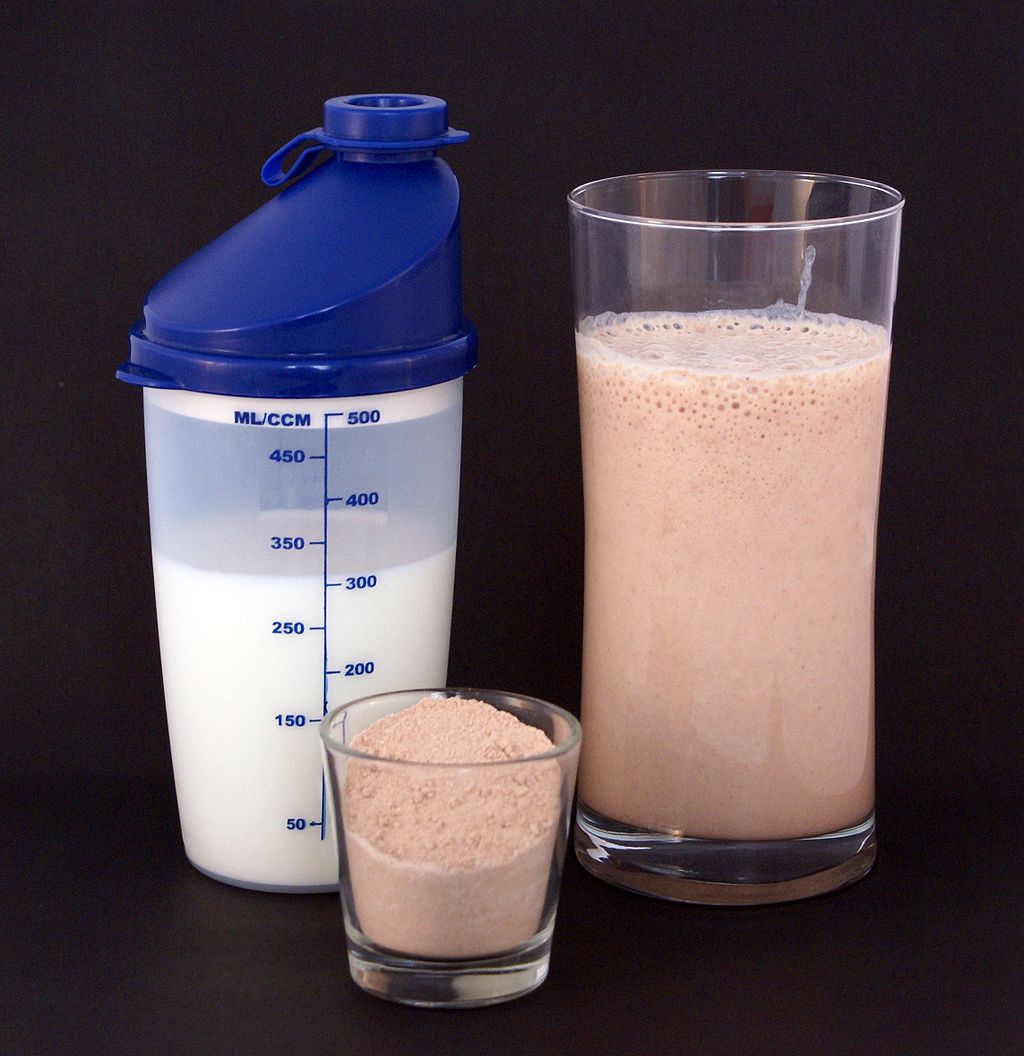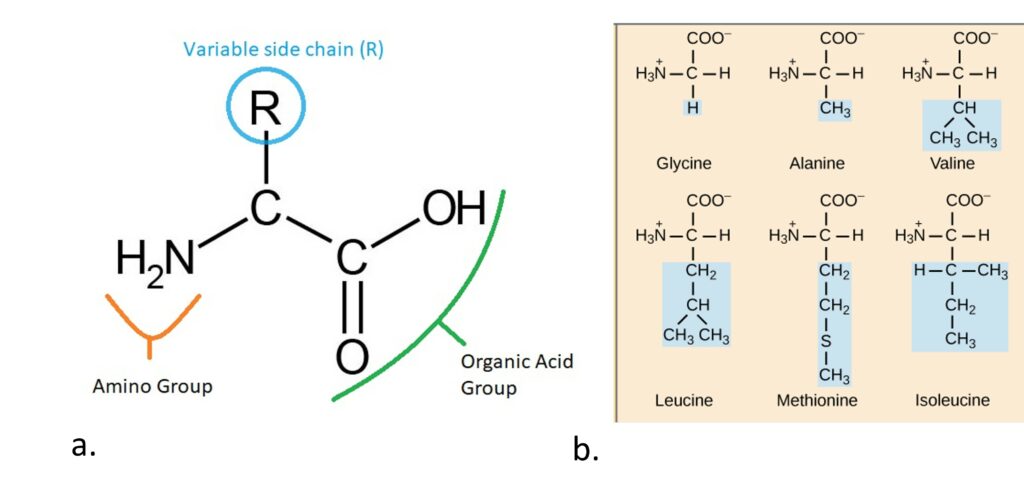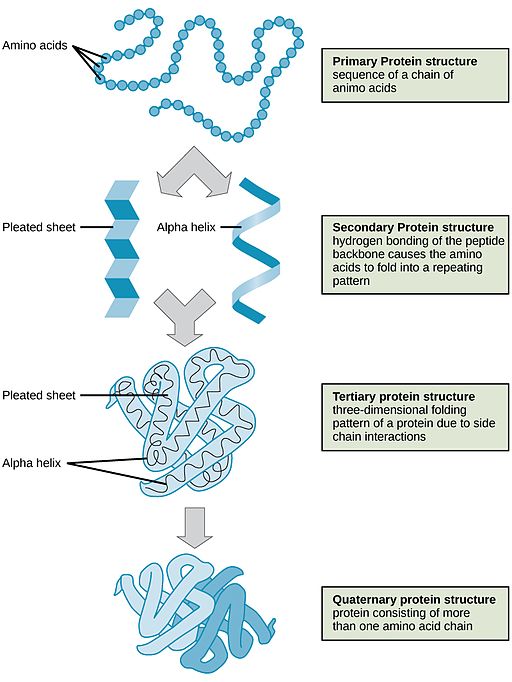Chapter 3 – Biological Molecules
3.6 Proteins
Created by: CK-12/Adapted by Christine Miller
Protein Shake

Drinks like this shake contain a lot of protein. Muscle tissue consists mainly of protein, so such drinks are popular with people who want to build muscle. Making up muscles is just one of a plethora of functions of this amazingly diverse class of biochemicals.
What Are Proteins?
Proteins are a major class of biochemical compounds made up of small monomer molecules called amino acids.
Every amino acid contains a central carbon which has three other chemical groups connected to it: an amino group (containing nitrogen), an organic acid group and a variable side group called the R-group (Figure 3.6.2a).

More than 20 different amino acids are typically found in the proteins of living things, each with a different R-group (Figure 3.6.2b). Small proteins may contain just a few hundred amino acids, while large proteins may contain thousands.
Protein Structure
When amino acids bind together, they may form short chains of two or just a few amino acids. These short chains are called peptides. When amino acids form long chains, the chains are called polypeptides. A protein consists of one or more polypeptides.
Proteins may have up to four levels of structure, from primary to quaternary. As a result, they can have tremendous diversity. Here are some additional details about the levels of protein structure:

Functions of Proteins
The diversity of protein structures explains why this class of biochemical compounds can play so many important roles in living things. What are the roles of proteins?
- Some proteins have structural functions. They may help cells keep their shape or make up muscle tissues.
- Many proteins are enzymes that speed up chemical reactions in cells. Enzymes are usually highly specific and accelerate only one or a few chemical reactions. Thousands of different biochemical reactions are known to be catalyzed by enzymes, including most of the reactions involved in metabolism. A reaction without an enzyme might take millions of years to complete, whereas with the proper enzyme, it may take just a few milliseconds!
- Other proteins are antibodies, which bind to specific foreign substances, like proteins on the surface of bacterial cells. This process targets the cells for destruction.
- Still other proteins carry messages or materials. Myoglobin, for example, is an oxygen-binding protein found in the muscle tissues of most mammals (including humans).
The chief characteristic of proteins that allows their diverse set of functions is their ability to bind to other molecules so specifically and tightly. Myoglobin can bind specifically and tightly with oxygen. The region of a protein responsible for binding with another molecule is known as the binding site. This site is often a depression on the molecular surface, determined largely by the tertiary structure of the protein. Changes to this tertiary structure, called denaturation, will therefore affect the function of the protein. Denaturation is often caused by extremes of pH or temperature that would be outside the range of normal conditions in which the protein would function. This is why heating an egg white will reverse its structure permanently!
Protein Consumption, Digestion, and Synthesis
Proteins are necessary in the diets of humans and other animals. We cannot make all the different amino acids we need, so we must obtain some of them from the foods we consume. In the process of digestion, we break down the proteins in food into free amino acids that can then be used to synthesize our own proteins. Protein synthesis from amino acid monomers takes place in all cells and is controlled by genes. Once new proteins are synthesized, they generally do not last very long before they are degraded and their amino acids are recycled. A protein’s lifespan in mammalian cells is generally just a day or two.
3.6 Summary
- Proteins are a major class of biochemical compounds. They’re made up of small monomer molecules called amino acids. More than 20 amino acids are commonly found in the proteins of living things. Proteins have tremendous diversity in terms of both structure and function.
- Long chains of amino acids form polypeptides. The sequence of amino acids in polypeptides makes up the primary structure of proteins. Proteins also have higher levels of structure. Secondary structure refers to configurations — such as helices and sheets — within polypeptide chains. Tertiary structure is a protein’s overall three-dimensional shape, which controls the molecule’s basic function. A quaternary structure forms if multiple protein molecules join together and function as a complex.
- Proteins help cells keep their shape, make up muscle tissues, act as enzymes or antibodies, and carry messages or materials. The chief characteristic that allows proteins’ diverse functions is their ability to bind specifically and tightly with other molecules.
- We cannot make all the amino acids we need to synthesize our own proteins, so we must obtain some of them from proteins in the foods we consume.
3.6 Review Questions
- What are proteins?
- Outline the four levels of protein structure.
- Identify four functions of proteins.
- Explain why proteins can take on so many different functions in living things.
- What is the role of proteins in the human diet?
- Can you have a protein with both an alpha helix and a pleated sheet? Why or why not?
- If there is a mutation in a gene that causes a different amino acid to be encoded than the one usually encoded in that position within the protein, would that affect:
- The primary structure of the protein? Explain your answer.
- The higher structures (secondary, tertiary, quaternary) of the protein? Explain your answer.
- The function of the protein? Explain your answer.
- What is the region of a protein responsible for binding to another molecule? Which level or levels of protein structure creates this region?
- What is the region of a protein responsible for binding to another molecule? Which level or levels of protein structure creates this region?
-
- True or False: You can tell the function of all proteins based on their quaternary structure.
- Explain what the reading means when it says that amino acids are “recycled.”
3.6 Explore More
Protein Structure and Folding by The Amoeba Sisters, 2018.
Attributions
Figure 3.6.1
Protein_shake by Sandstein, on Wikimedia Commons, is used under a CC BY 3.0 (https://creativecommons.org/licenses/by/3.0) license.
Figure 3.6.2
Structures of Protein by OpenStax, on Wikimedia Commons, is used under a CC BY 4.0 (https://creativecommons.org/licenses/by/4.0) license.
References
Amoeba Sisters. (2018, September 24). Protein structure and folding. YouTube. https://www.youtube.com/watch?v=hok2hyED9go
OpenStax. (2012, Aug 22). Figure 9. The four levels of protein structure can be observed in these illustrations. (credit: modification of work by National Human Genome Research Institute). In Biology. OpenStax CNX. © Rice University. https://cnx.org/contents/GFy_h8cu@10.53:2zzm1QG9@7/Proteins (last revised May 27, 2016).
A class of biological molecule consisting of linked monomers of amino acids and which are the most versatile macromolecules in living systems and serve crucial functions in essentially all biological processes.
Amino acids are organic compounds that combine to form proteins.
The smallest unit of life, consisting of at least a membrane, cytoplasm, and genetic material.
Biological molecules that lower amount the energy required for a reaction to occur.
A chemical reaction is a process that leads to the chemical transformation of one set of chemical substances to another.
An antibody, also known as an immunoglobulin, is a large, Y-shaped protein produced mainly by plasma cells that is used by the immune system to neutralize pathogens such as pathogenic bacteria and viruses.
The change in the 3-dimensional shape of a protein due to bonding in the tertiary, quaternary or secondary structure of the protein.
A molecule that can undergo polymerization, creating macromolecules. Large numbers of monomers combine to form polymers in a process called polymerization.

